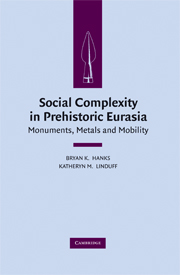Book contents
- Frontmatter
- Contents
- Contributors
- Foreword: From Myth to Method: Advances in the Archaeology of the Eurasian Steppe
- CHAPTER 1 Introduction: Reconsidering Steppe Social Complexity within World Prehistory
- PART ONE FRAMING COMPLEXITY
- PART TWO MINING, METALLURGY, AND TRADE
- PART THREE FRONTIERS AND BORDER DYNAMICS
- PART FOUR SOCIAL POWER, MONUMENTALITY, AND MOBILITY
- CHAPTER 17 Introduction
- CHAPTER 18 Re-writing Monumental Landscapes as Inner Asian Political Process
- CHAPTER 19 Socially Integrative Facilities and the Emergence of Societal Complexity on the Mongolian Steppe
- CHAPTER 20 Pre-Scythian Ceremonialism, Deer Stone Art, and Cultural Intensification in Northern Mongolia
- Index
CHAPTER 17 - Introduction
from PART FOUR - SOCIAL POWER, MONUMENTALITY, AND MOBILITY
Published online by Cambridge University Press: 26 January 2010
- Frontmatter
- Contents
- Contributors
- Foreword: From Myth to Method: Advances in the Archaeology of the Eurasian Steppe
- CHAPTER 1 Introduction: Reconsidering Steppe Social Complexity within World Prehistory
- PART ONE FRAMING COMPLEXITY
- PART TWO MINING, METALLURGY, AND TRADE
- PART THREE FRONTIERS AND BORDER DYNAMICS
- PART FOUR SOCIAL POWER, MONUMENTALITY, AND MOBILITY
- CHAPTER 17 Introduction
- CHAPTER 18 Re-writing Monumental Landscapes as Inner Asian Political Process
- CHAPTER 19 Socially Integrative Facilities and the Emergence of Societal Complexity on the Mongolian Steppe
- CHAPTER 20 Pre-Scythian Ceremonialism, Deer Stone Art, and Cultural Intensification in Northern Mongolia
- Index
Summary
The three contributions in this section shift the attention to Eurasia's eastern steppes, specifically Mongolia's rich archaeological landscape during the Bronze and Iron Ages (second to first millennium bce). Already by the late nineteenth century, commentators had noted the region's many types of ancient stone-built structures, including slab burials, delineated by flat standing stones; structurally complex – and often massive – khirigsuurs; standing deer stones; and small mounded slope burials. This early archaeological record owes its enduring scholarly appeal not only to the high visibility of its numerous monumental sites, which stand out among Mongolia's treeless valley bottoms and hillsides, but also to the materials and information recovered from the sites themselves. Khirigsuurs and the other types of burials have yielded human and animal remains, while deer stones display enigmatic carved designs of uncertain symbolism. It is fair to say that research on this period of Mongolia's prehistory, including the three chapters in this part, has in some way or other remained tethered to these prominent sites and features.
Other aspects of Mongolia's early archaeological landscape have also generated interest among scholars. Some of the monumental structures seem to make an appearance at approximately the same time at the end of the second millennium bce, signaling the possibility of a significant cultural transformation. All three chapters address, in some way or other, the issue of the emergence and development of this monumental landscape.
- Type
- Chapter
- Information
- Social Complexity in Prehistoric EurasiaMonuments, Metals and Mobility, pp. 323 - 329Publisher: Cambridge University PressPrint publication year: 2009
- 1
- Cited by

